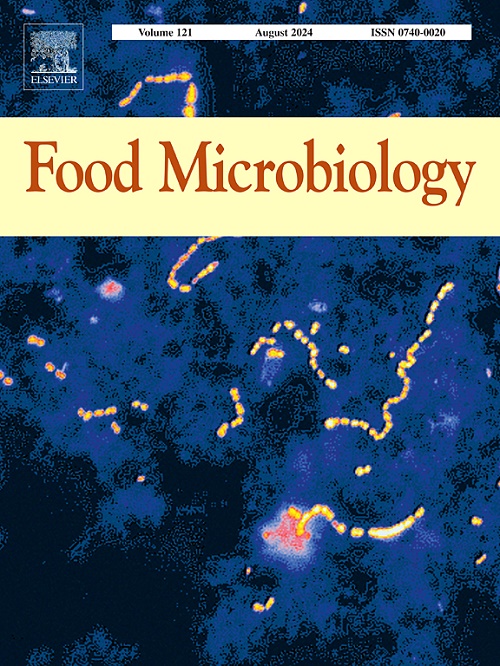氧化锌纳米颗粒增强了次氯酸钠消毒剂降低病原菌对不锈钢表面粘附的效率
IF 4.5
1区 农林科学
Q1 BIOTECHNOLOGY & APPLIED MICROBIOLOGY
引用次数: 0
摘要
将商业消毒剂与氧化锌纳米颗粒等抗菌剂联合使用以提高消毒效果可能是一种很有前途的病原菌控制策略。在此背景下,本研究的目的是利用肉汤微量稀释法CLSI M07-A10,确定次氯酸钠消毒剂、ZnO纳米颗粒以及Mn-、Ce-和共掺杂ZnO纳米颗粒(掺杂浓度为10%、20%、30%)对革兰氏阴性菌大肠杆菌和鼠伤寒沙门氏菌,革兰氏阳性菌金黄色葡萄球菌和单核增生李斯特菌的最小抑制浓度(MIC)。采用棋盘微稀释法考察次氯酸钠与纯ZnO纳米粒子的类型相互作用。结果表明,ZnO纳米颗粒是比次氯酸钠需要更高浓度才能抑制细菌生长的药剂,因此它们的组合可以实现协同效应。在氧化锌纳米颗粒中掺杂锰和钴,提高了氧化锌纳米颗粒对革兰氏阳性菌的抗菌活性。总的来说,本研究旨在通过菌落形成单位计数法评估单独处理(次氯酸钠和纳米ZnO)及其组合对暴露于不同温度(7°C, 25°C, 37°C)和pH(4.5, 7.0, 8.5)下不锈钢(AISI 304)表面初始细菌粘附的有效性。结果表明,氧化锌纳米颗粒在减少细菌粘附方面比次氯酸钠更有效,而联合处理的效果优于单独处理,突出了其作为防止细菌生物膜的新型消毒剂的优势。此外,温度和pH值影响细菌粘附的数据提供了细菌如何在食品加工环境中生存的全面见解,这有助于评估污染风险。本文章由计算机程序翻译,如有差异,请以英文原文为准。

ZnO nanoparticles enhance the efficiency of sodium hypochlorite disinfectant in reducing the adhesion of pathogenic bacteria to stainless steel surfaces
The use of commercial disinfectant in combination with other antimicrobial agent such as ZnO nanoparticles to improve disinfection efficacy could be a promising strategy in the control of pathogenic bacteria. In this context, the aim of study was to determine the minimum inhibitory concentration (MIC) of sodium hypochlorite disinfectant, ZnO nanoparticles as well as Mn-, Ce-, and Co-doped ZnO nanoparticles (doping concentrations 10%, 20%, 30%) against gram-negative bacteria Escherichia coli and Salmonella Typhimurium, and gram-positive bacteria Staphylococcus aureus and Listeria monocytogenes using the broth microdilution method CLSI M07-A10, while the checkerboard microdilution method was carried out to assess the type interaction of sodium hypochlorite in combination with pure ZnO nanoparticles. The results specified that ZnO nanoparticles were agents that required higher concentrations to inhibit bacterial growth than sodium hypochlorite, whereby a synergistic effect was achieved in their combination. It was also revealed that doping of Mn and Co in ZnO nanoparticles improved antibacterial activity against gram-positive bacteria. Generally, this study aimed to evaluate the effectiveness of individual treatments (sodium hypochlorite and ZnO nanoparticles) and their combination on initial bacterial adhesion to stainless steel surfaces (AISI 304) exposed to different temperatures (7 °C, 25 °C, 37 °C) and pH (4.5, 7.0, 8.5) using colony-forming units count method. It was evident that ZnO nanoparticles were more effective than sodium hypochlorite in reducing bacterial adherence, while the combined tretmant showed a better effect than any individual treatment alone, highlighting its advantages as a novel disinfectant to prevent bacterial biofilms. Furthermore, data that temperature and pH affected bacterial adhesion provide comprehensive insight how bacteria survive in the food processing environments, which could assist in assessment the risk of contamination.
求助全文
通过发布文献求助,成功后即可免费获取论文全文。
去求助
来源期刊

Food microbiology
工程技术-生物工程与应用微生物
CiteScore
11.30
自引率
3.80%
发文量
179
审稿时长
44 days
期刊介绍:
Food Microbiology publishes original research articles, short communications, review papers, letters, news items and book reviews dealing with all aspects of the microbiology of foods. The editors aim to publish manuscripts of the highest quality which are both relevant and applicable to the broad field covered by the journal. Studies must be novel, have a clear connection to food microbiology, and be of general interest to the international community of food microbiologists. The editors make every effort to ensure rapid and fair reviews, resulting in timely publication of accepted manuscripts.
 求助内容:
求助内容: 应助结果提醒方式:
应助结果提醒方式:


